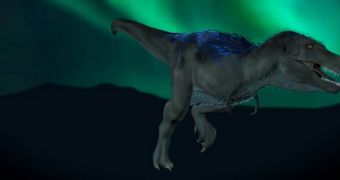A team of investigators from the United States reports the first-ever discovery of a dinosaur fossil in the extreme environment high above the Arctic circle, near the North Pole. The group says that no other such fossils have been detected at high latitude anywhere else in the world. The creature that left the fossil behind is believed to have looked remarkably similar to a Tyrannosaur Rex, just much smaller.
The research group was led by paleontologists Anthony Fiorillo and Ronald Tykoski, who are both based at the Perot Museum of Nature and Science in Dallas, Texas. They say that the pint-sized tyrannosaur discovered along the banks of an Alaskan river probably lived there around 70 million years ago. This is just 4 to 5 million years before the Cretaceous-Paleogene (K-T) extinction event.
Discovering the first known tyrannosaur species at either pole is a major breakthrough and one that raises significant questions. Dinosaurs were giant lizards and, like all lizards, absolutely required the Sun in order to regulate their body temperatures. How they were able to survive so near the North Pole when they were cold-blooded is something that researchers have yet to figure out.
The new species, Nanuqsaurus hoglundi, has been named based on nanuq, which is the Inupiat word for polar bear. It is entirely possible that the creature was a direct descendant of T. Rex populations that lived in much warmer climates, but somehow found a way to endure in extremely-cold environments.
According to the new research, which is detailed in the March 12 issue of the open-access journal PLoS ONE, the diminutive T. Rex species measured just 7 meters (23 feet) from head to tail. Its larger and more renowned brethren were 12 meters (39.3 feet) long. This decreased sized may have been triggered by the extreme day-and-night conditions above the Arctic Circle.
“I never thought I’d see a dwarf tyrannosaur come to light,” says paleontologist Thomas Carr, who is based at the Carthage College in Kenosha, Wisconsin. The expert was not involved in the new study. “There was something about that environment that selected for tyrannosaurs developing a smaller body size,” adds Fiorillo, quoted by Nature News.
The first fragments of the rock containing the N. hoglundi fossil were unearthed in 2006, but the team had no way of knowing if the remains belonged to a dinosaur or to some other species of animal, more well-adapted to living in Arctic environments.
“Only in the last year or so, after some other tyrannosaur papers came out, we were able to plug these fragments into those analyses – and a little light bulb went on over our heads. We said, holy smokes, this thing really is different,” Tykoski comments. The discovery was made in the North Slope region.
Shortly after submitting the PLoS ONE paper for publication, the team traveled back to Alaska and found the second half of the original N. hoglundi skull they uncovered some 7 years ago. Discovering additional fragments will make studying this dinosaur significantly easier.

 14 DAY TRIAL //
14 DAY TRIAL //